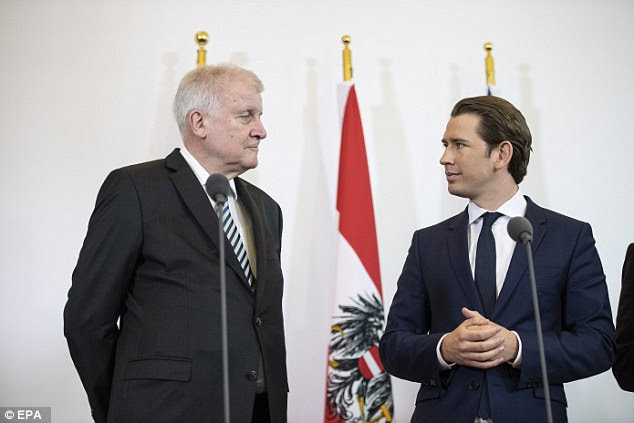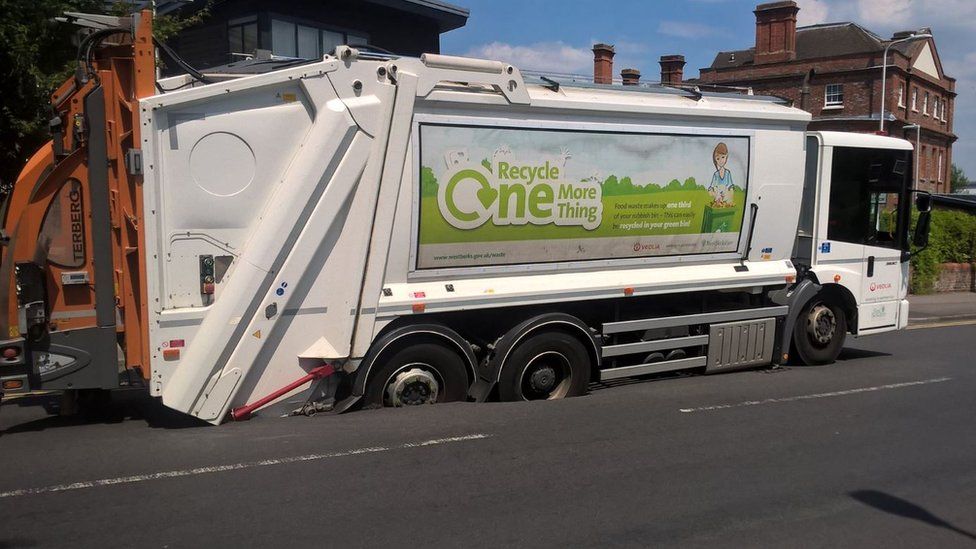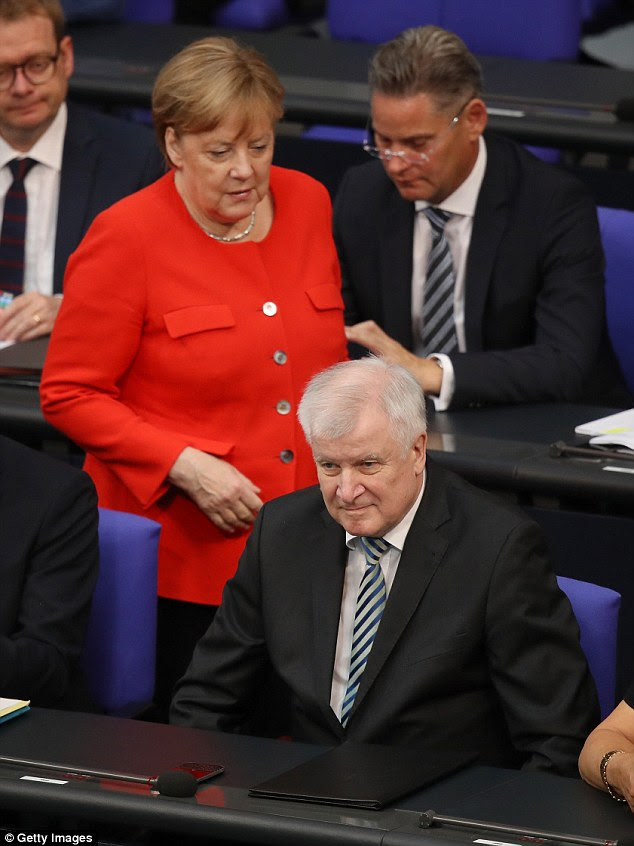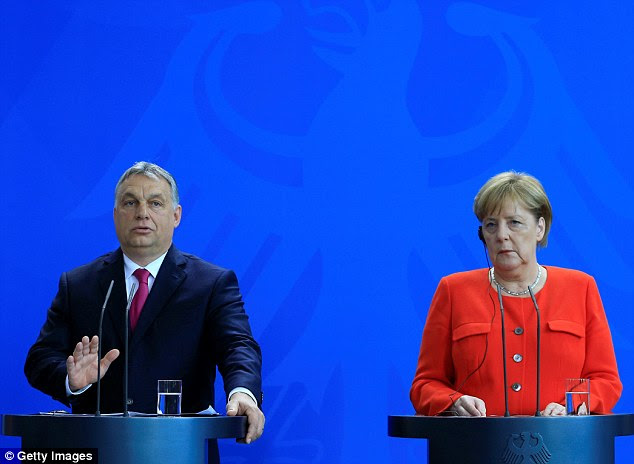Daily Mail
By Reuters and Julian Robinson for Mail Online
- Austria, Germany, Italy to discuss closing Mediterranean migrant route into EU
- Talks were announced by Germany’s hardline Interior Minister Horst Seehofer
- Comes as Germany considers migrant measures at shared border with Austria
- Angela Merkel has accused hardline Hungarian PM failing to respect ‘humanity’ with his immigration policies.
Europe will shut its southern doors to migrants under plans to be discussed by Germany, Austria and Italy next week, it has emerged.
Germany’s hardline Interior Minister Horst Seehofer said talks would take place between the three nations on how to close the Mediterranean route into the EU.
His announcement comes after a meeting with Austrian Chancellor Sebastian Kurz and amid plans being considered by Germany’s government for new immigration measures at their shared border.
Germany’s hardline Interior Minister Horst Seehofer (left, today) said talks would take place between the three nations on how to close the Mediterranean route into the EU. It comes after he held a meeting with Austrian Chancellor Sebastian Kurz (right)
Seehofer insisted the measures would not make Austria responsible for people arriving there who had already sought asylum in another European Union country.
Kurz said the two sides agreed Germany’s plans at the border would not harm Austria and that they would instead work together on stemming illegal immigration.
‘We agreed … that next week there will be a meeting of the German, Austrian and Italian interior ministers with the goal of taking measures to shut the Mediterranean route into Europe, to make sure that illegal immigration to Europe on this route is stopped,’ Kurz told a joint news conference.
Seehofer said the meeting would happen around the time of a European interior ministers’ meeting in the Austrian city of Innsbruck on Thursday and Friday of next week.
Related Articles
The number of migrant trips across the Mediterranean has fallen dramatically, with about 45,000 people making it to Europe across the sea this year compared to over a million in 2015, but politically it has become ever more divisive.
Last week, European Union states agreed to tighten their external borders and spend more in the Middle East and North Africa to bring down the number of migrants and to set up new centres to handle new arrivals.
Earlier today, Seehofer said a new plan to establish so-called ‘transit centers’ at the Austrian border to quickly process new migrant arrivals envisions sending people directly back to where they first entered the European Union, primarily Greece and Italy.
Seehofer (pictured with Angela Merkel today) said the meeting would happen around the time of a European interior ministers’ meeting in the Austrian city of Innsbruck on Thursday and Friday of next week
Austrian leader Sebastian Kurz takes up EU presidency
Saying he was ‘convinced these will be very difficult talks,’ Seehofer said ‘it is a problem for all of Europe and we want to negotiate with Italy and Greece’ to send them back migrants who had already registered and applied for asylum in those countries, the main entry points to the EU.
The comments in Vienna came after talks with Kurz, who backed the plan, saying that he hoped it could be resolved during his country’s EU presidency, which just began and lasts six months.
Meanwhile, German Chancellor Angela Merkel has accused Hungary’s right-wing Prime Minister Viktor Orban of failing to respect ‘humanity’ with his immigration policy, days after she made key border protection concessions to hardliners who have embraced Budapest’s anti-migrant stance.
In a remarkable clash on European values at a time when migration threatens the cohesion of the EU, Merkel and Orban each presented themselves as staunch defenders of the bloc’s very purpose.
‘The problem as I see it, and where the difference lies, is that we must always remember that we are talking about human beings,’ Merkel told a joint news conference.
‘It is about human beings who come to us, and about Europe’s basic message. And that is humanity.’
Merkel said securing the EU’s external borders was not about creating a ‘fortress’ against people brought by smugglers on perilous journeys across the Sahara and the Mediterranean. She said the bloc needed to sign accords with African nations to ensure legal migration was still possible.
Migrant routes to Europe: What are the long and perilous routes thousands of people are taking?
Illegal migrants seeking to enter Europe use various long and perilous routes that are evolving as authorities attempt to stem the flow of new arrivals.
Here is an overview of how people are reaching the continent.
How do migrants reach Europe?
Most arrive by crossing the Mediterranean, according to the UN High Commissioner for Refugees (UNHCR), with 172,000 entering through Greece, Italy and Spain last year.
The number of arrivals is down sharply from the peak in 2015, when 1.02 million entered Europe via the Mediterranean.
Since the start of this year there have been 44,370 arrivals; that is far below the 48,000 who entered Greece over just five days in October 2015.
Maltese paramedics aid migrants on board the Lifeline NGO rescue vessel stranded in the Mediterranean with more than 200 migrants as it finally berthed in Valletta, Malta, on 27 June 2018
What are the routes across the Mediterranean?
Most of the crossings last year were from Libya or Tunisia into Italy, known as the ‘Central Mediterranean’ route, says the EU’s Frontex border agency.
It was used by 118,962 people, mostly Nigerians, Guineans and Ivorians.
But arrivals via this route have plunged 75 per cent since a controversial July 2017 deal between Rome and the Libyan coastguard.
Crossings have also dropped sharply from Turkey to Greece, the ‘Eastern Mediterranean’ route. After close to 900,000 migrants in 2015, Frontex recorded only 42,000 last year, essentially Afghans, Iraqis and Syrians.
The decline came after a 2016 deal between the EU and Turkey in which Ankara agreed to take back illegal migrants landing on Greek islands in exchange for billions of euros in aid and other incentives.
More recently there has been a sharp increase in the use of a route between Morocco and Spain.
Nearly abandoned until 2000, this ‘Western Mediterranean’ route saw 23,000 crossings last year, mostly of Algerians, Ivorians and Moroccans.
Since the start of 2018, 17,522 people have entered Europe via Spain, compared to 16,452 via Italy and 13,120 via Greece, the UNHCR says.
The renewed popularity of the route is straining Spain’s law-enforcement response and its social safety networks.
Of the 972 who lost their lives at sea trying to make the crossing to Europe, nearly a third (292) died trying to reach Spain.
Other ways into Europe
The main secondary route into the EU is through the western Balkans into Eastern Europe.
Around 12,000 people entered this way last year, most of them Afghans, Iraqis and Pakistanis – a sharp reduction from the 760,000 in 2015.
But this path joins up with one used by migrants who have already passed through Turkey and Greece, meaning the actual numbers of new arrivals don’t always add up.
Routes into Europe are constantly evolving: according to the French embassy in Slovenia, a new one is developing from Greece through Albania, Croatia and Slovenia, with nearly 1,800 crossings between January and May this year.
An ‘Arctic route’ was briefly in operation 2015 when about 100 migrants crossed a day from Russia into Norway on bicycle.
Getting through Africa
There are also several routes from African countries to departure points on the Mediterranean, some involving a dangerous crossing of the Sahara desert.
A Somali leaving from Mogadishu, for example, could travel via Addis Ababa, Khartoum, Cairo and then Tripoli, ahead of the sea crossing to Europe.
An Ivorian leaving from Abidjan might pass via Ouagadougou, Niamey and Agadez – Niger’s renowned ‘gateway to the Sahara’ – to reach Libya.
The high human toll
The UNHCR says it has registered 16,607 migrants dead or missing at sea since 2014.
To this should be added the toll for the perilous Sahara crossing, which the International Organization for Migration says is probably as high as that for the Mediterranean.
United for Intercultural Action, a Dutch group which records the identities of victims of the crossings, says at least 34,361 migrants have died trying to reach Europe since 1993.
‘Thousands of others have never been found,’ it says.
‘The soul of Europe is humanity and this soul, if we want to maintain it – if Europe with its values is to continue to play a role in the world, then Europe cannot simply turn its back on hardship and suffering,’ she said.
Orban, a populist firebrand who has spearheaded a drive against European asylum policies fiercely defended by Merkel, was making his first visit to Berlin in three years.
He agreed that he and Merkel had fundamentally different approaches to migration ‘and how to help people in a humanitarian way’.
Orban said Germany could be grateful for the fence Hungary had built on its borders with Serbia and Croatia, which he said was guarded ’24 hours a day by 8,000 armed men’.
‘Otherwise 4,000 to 5,000 refugees would be arriving in Germany per day. That is solidarity – solidarity that can be taken seriously,’ he said.
Only this week, Merkel ended a tense showdown with her arch-conservative Interior Minister Seehofer by agreeing to tighten border controls and set up closed ‘transit centres’ to hold migrants on the Austrian frontier.
German Chancellor Angela Merkel (right, today) has accused Hungary’s right-wing Prime Minister Viktor Orban (left) of failing to respect ‘humanity’ with his immigration policy, days after she made key border protection concessions to hardliners who have embraced Budapest’s anti-migrant stance
The weeks-long row had threatened to topple her ‘grand coalition’ government after just 100 days in power. Influential news weekly Der Spiegel said Thursday that the hard-fought compromise marked an ‘Orbanisation’ of Merkel’s policies.
Seehofer’s Christian Social Union party in Bavaria state actively courted Orban in recent years in an affront to Merkel.
Spiegel said she now appeared to recognise that EU hardliners could no longer be ignored or stonewalled.
Merkel’s fateful decision in 2015 to leave the German border open to those fleeing Middle East conflict zones was prompted primarily by Orban’s refusal to offer them refuge and blocking the so-called Balkan route into the EU.
At the time, Orban railed against Merkel’s ‘moral imperialism’ while the chancellor, who grew up in communist East Germany, said she had seen enough walls in Europe for a lifetime.
Since then, far-right parties have joined governments in key countries such as Italy and Austria while the anti-immigration Alternative for Germany party won nearly 100 seats in the Bundestag lower house.
Merkel’s tone toward Orban had softened of late.
Last week she even thanked the Hungarian leader for his efforts to bolster the EU’s external borders, while Orban declared the ‘enormous success’ of his tough stance in the conclusions of an EU summit last week.
But Merkel on Thursday denied that she had sacrificed European principles of open borders and compassion toward qualified asylum seekers on the altar of power politics.
Merkel, who has said that Europe’s fate could be determined by the migration issue, said the accords she had hammered out at the EU summit and within her own government were aimed at keeping the asylum system from collapsing.
The German solution, however, is dependent on bilateral agreements with EU states to take back asylum seekers who previously registered in their countries.
Budapest has until now rebuffed such overtures, although Merkel noted the number of people who would qualify for return there was ‘very, very small’.
Seehofer was in Vienna Thursday to discuss similar cooperation with Austrian Chancellor Sebastian Kurz.











